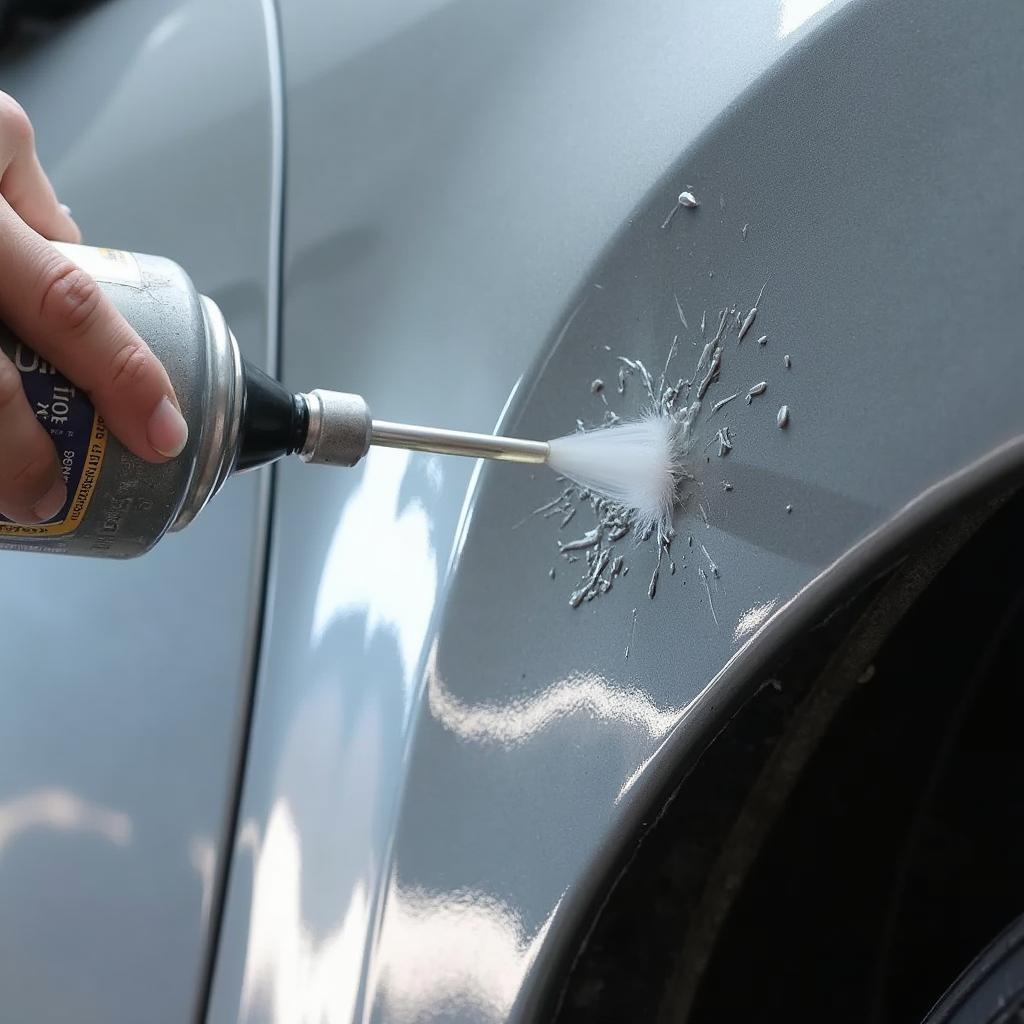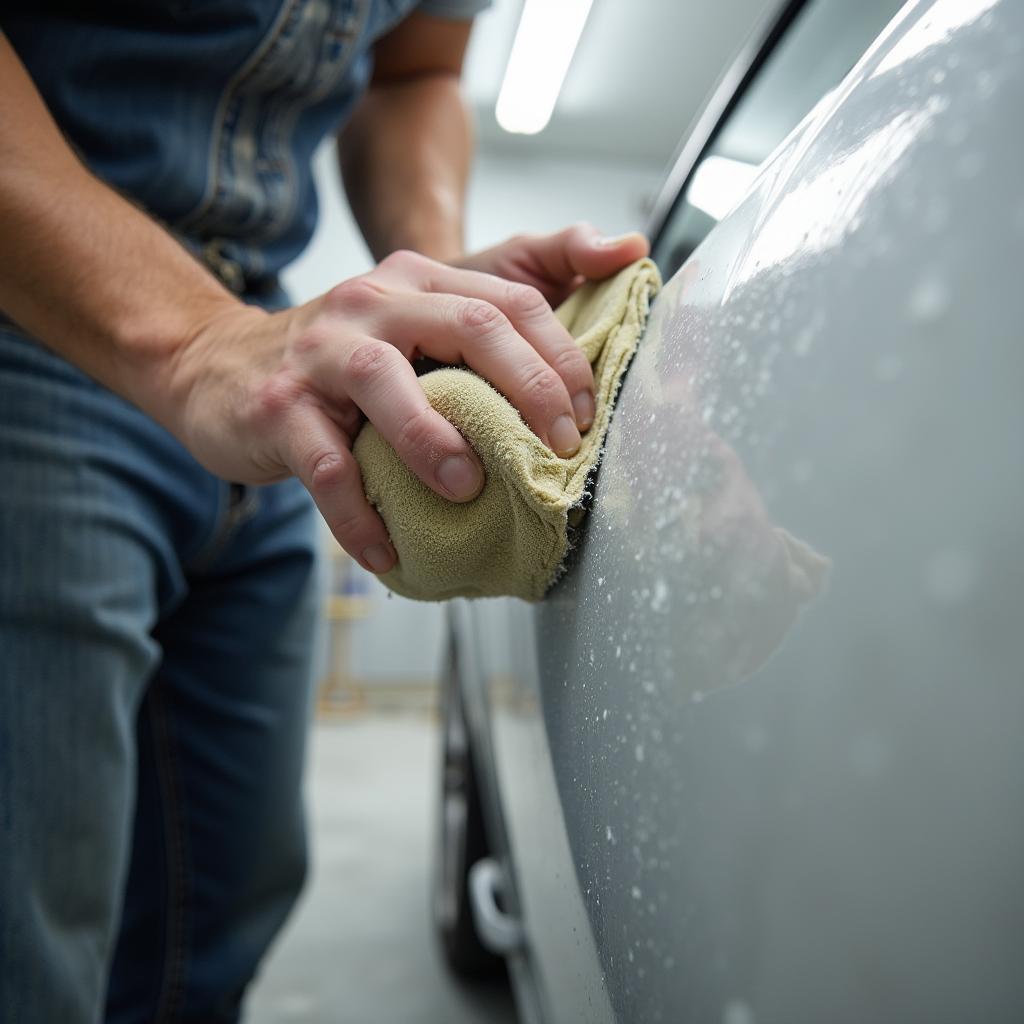
Car body repair using epoxy
When it comes to repairing your car’s metal bodywork, using the best epoxy can make all the difference between a seamless fix and a recurring headache. Unlike traditional body fillers, epoxy for metal car body repairs provides a strong, durable bond that can withstand vibrations, impact, and harsh weather conditions.
 Car body repair using epoxy
Car body repair using epoxy
Choosing the right epoxy, however, can be overwhelming with the wide array of options available. This comprehensive guide will walk you through everything you need to know about choosing the Best Epoxy For Metal Car Body Repairs, ensuring a professional and long-lasting result.
Understanding Epoxy for Metal Car Body Repairs
Before we delve into the specifics, let’s clarify what exactly epoxy is and why it’s a superior choice for metal car bodywork.
Epoxy is a two-part adhesive consisting of a resin and a hardener. When mixed, these components initiate a chemical reaction, resulting in a durable and rigid plastic-like material.
Here’s why epoxy stands out:
- Superior Adhesion: Epoxy forms a powerful bond with metal surfaces, ensuring the repair lasts.
- Unmatched Durability: Once cured, epoxy is incredibly strong and resistant to impacts, vibrations, and temperature fluctuations.
- Corrosion Resistance: Unlike some body fillers, epoxy protects the metal from rust and corrosion, extending the lifespan of your repair.
- Versatile Application: Epoxy can be sanded, shaped, and painted, allowing for a seamless and professional-looking finish.
 Applying epoxy to a car's metal surface
Applying epoxy to a car's metal surface
Choosing the Right Epoxy: Key Factors to Consider
With numerous epoxy products on the market, each boasting unique features, selecting the ideal one for your specific needs is crucial. Here are the key factors to keep in mind:
1. Type of Metal: Different metals have varying properties. Ensure the chosen epoxy is compatible with your car’s specific metal type.
2. Extent of Damage: For minor dents and scratches, a lightweight epoxy is sufficient. However, significant damage necessitates a heavy-duty, high-strength formula.
3. Application Method: Consider whether you prefer a spreadable paste, a pourable liquid, or a moldable putty.
4. Cure Time: Choose a product with a cure time that aligns with your project timeline.
5. Color: While not essential, selecting an epoxy close to your car’s paint color can simplify the finishing process.
Top Tips for Applying Epoxy
Applying epoxy correctly is paramount for achieving a flawless, long-lasting repair. Here’s a step-by-step guide to ensure optimal results:
- Surface Preparation: Thoroughly clean the damaged area, removing rust, paint, and any contaminants. A clean surface ensures optimal adhesion.
- Mixing the Epoxy: Follow the manufacturer’s instructions meticulously, combining the resin and hardener in the correct proportions.
- Applying the Epoxy: Apply the mixed epoxy to the prepared surface, using a putty knife or spreader.
- Shaping and Smoothing: While the epoxy is still workable, shape and smooth the surface, removing any excess material.
- Curing Time: Allow the epoxy to cure completely, following the manufacturer’s recommended curing time.
- Sanding and Finishing: Once cured, sand the epoxy smooth, blending it seamlessly with the surrounding bodywork.
- Priming and Painting: Prime and paint the repaired area, matching the existing paint color for a professional finish.
 Sanding car body epoxy after curing
Sanding car body epoxy after curing
Conclusion
Choosing the best epoxy for metal car body repairs is an investment in a durable and long-lasting fix. By understanding the key factors and following proper application techniques, you can achieve professional-quality results that will keep your car looking its best for years to come.
Remember, if you’re unsure about any aspect of the repair process, don’t hesitate to consult a professional auto body specialist.
Need expert advice or assistance with your car repairs? Contact us via WhatsApp: +1(641)206-8880 or Email: [email protected]. Our dedicated team is available 24/7 to assist you.
